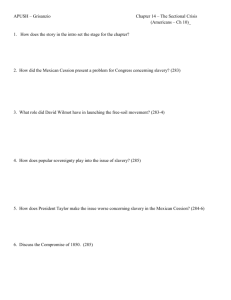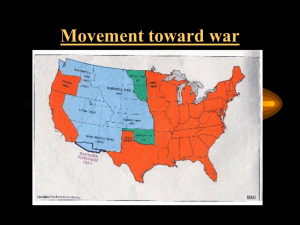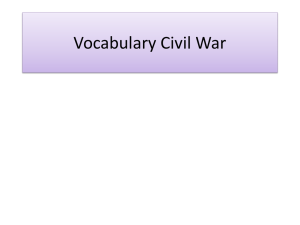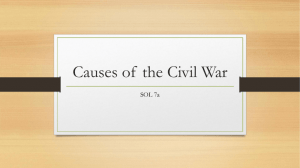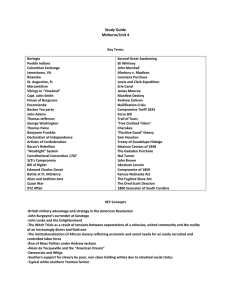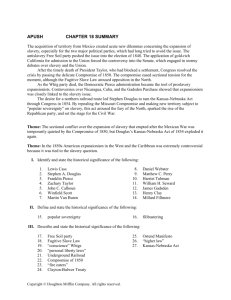UbD - kveritasushistory
advertisement
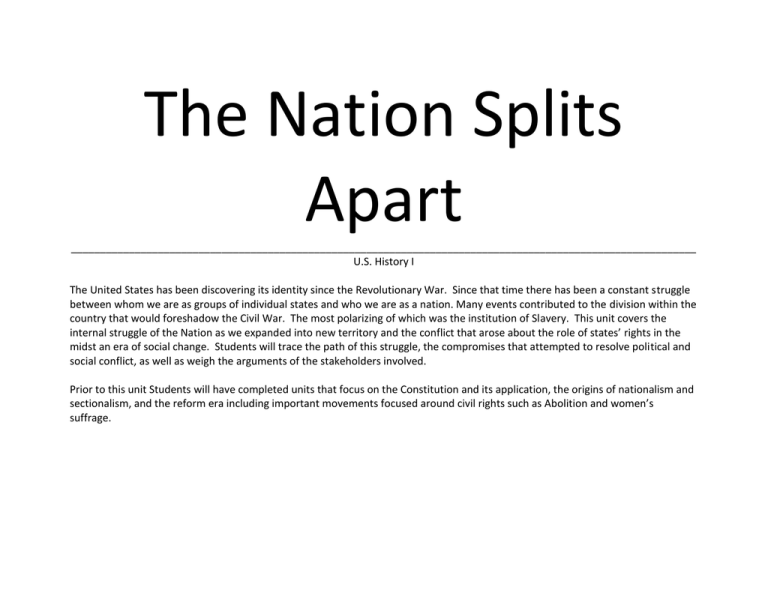
The Nation Splits Apart ____________________________________________________________________________________________________________ U.S. History I The United States has been discovering its identity since the Revolutionary War. Since that time there has been a constant struggle between whom we are as groups of individual states and who we are as a nation. Many events contributed to the division within the country that would foreshadow the Civil War. The most polarizing of which was the institution of Slavery. This unit covers the internal struggle of the Nation as we expanded into new territory and the conflict that arose about the role of states’ rights in the midst an era of social change. Students will trace the path of this struggle, the compromises that attempted to resolve political and social conflict, as well as weigh the arguments of the stakeholders involved. Prior to this unit Students will have completed units that focus on the Constitution and its application, the origins of nationalism and sectionalism, and the reform era including important movements focused around civil rights such as Abolition and women’s suffrage. Stage 1 Desired Results ESTABLISHED GOALS Transfer Students will be able to independently use their learning to… Describe how the different economies Understand how recurring patterns in history can inform judgments about current and cultures of the North and South events and other issues. contributed to the growing importance of Analyze and resolve conflicts in order to work and live cooperatively with others. sectional politics in the early 19th century. Apply knowledge of political and social systems to participate actively as an informed (H) citizen of a democracy Meaning Critical developments leading to the Civil UNDERSTANDINGS ESSENTIAL QUESTIONS War. U1 – Regional interests influence beliefs and Q1 – How do the needs and interests of a the Compromise of 1850 cultural identity. particular region influence public opinion? the Kansas-Nebraska Act (1854) John Brown’s raid on Harper’s Ferry U2 – Political tension leads to conflict Q2 – Why do we pick sides? (1859) U3 – Some conflicts leave little room for Q3 – Is compromise always effective? USI.38 Analyze Abraham Lincoln’s compromise presidency, including: Q4-In what ways do the actions of Lincoln-Douglas debates (1858) U4-The actions of the government can have government effect its people? Seminal Primary Documents to profound effects on its people both positive Consider: Lincoln’s “House Divided” and negative. Q5 – What unites people? speech (1858) U5 – Ideologies draw people together to fight Q5 –During the mid -19th Century, was the Views on slavery for a common cause United States in a state of CounterRevolution?(or were its conflicts part of the CC reading standards for Literacy in Social U5 – Critical divisive events in the postnatural evolution of a democracy?) Studies Revolutionary War era, including conflicts RS 1.9-10 Cite specific textual evidence to over slavery, led to civil war( A variety polarizing events precipitated the civil war) support analysis of primary and secondary sources RS 7. 9-10 Integrate quantitative or technical analysis (e.g., charts, research data) with qualitative analysis in print or digital text RS 9. 9-10 Compare and contrast treatments of the same topic in several primary and secondary sources CC-Literacy writing standards for History and Social Studies WS 1.9-10 Write arguments focused on discipline-specific content. WS 4. 9-10 Produce clear and coherent writing in which the development, organization, and style are appropriate to task, purpose, and audience. WS 9. 9-10 Draw evidence from informational texts to support analysis, reflection, and research. STUDENTS WILL KNOW… Content Specific Key Terms: Popular sovereignty Radical Delegate Platform Prohibit Free-soilers Freeport doctrine Acquisition STUDENTS WILL BE SKILLED AT… Activating prior knowledge of the economics of slavery and the differences between the Northern and southern economies and culture(U1, Q1) Interpreting historical and political maps between the years 1820-1850(U1,Q1,Q4) Analyzing primary and secondary sources Academic vocabulary: Reflect Assess Analyze Arguing a position to justify or Condemn the actions of John Brown(U1,U2,U5,Q2) The conditions of slavery in the south(U1) Analyze pre-war sectional economies(U1) By 1850 the national debate centered on the expansion of slavery into the territories(U1,U3,Q2) Writing persuasively and with clearly defined and explained claims and counter claims(U1) Assessing the roots of political polarization and applying that knowledge to growing sectionalism(U1,U2,U3,Q1,Q2,Q3) The role of popular sovereignty in the Compromise of 1850 and the KansasNebraska Act(Q3) Connecting political strategies to resolve the slavery issue with the resulting highly charged Analyzing alternate historical perspectives (U1,Q1) political debate over the issue in the 1850’s(U2,U4,Q4) The causes and effects of “Bleeding Kansas”(U1,U2,U5,Q2) The role of the federal government in resolving territorial disputes(U2,U4) The significance and outcomes of the Dred Scott Decision(U4,U5) John Browns role in defining radical antislavery politics(U3,U5,Q2,Q3,Q5) Lincolns rise to National politics and the Birth of the Republican party(U3,U4) Evaluative Criteria Explanation Interpretation Application Perspective Empathy Self-Knowledge Stage 2 - Evidence Assessment Evidence TRANSFER TASK(S): CEPA –Political speeches representing party platforms in the late 1850’s Goal: Your goal is to persuade the American people that you are the best candidate to help the United States progress in the right direction in an upcoming election. Role: You are either a Republican or a Democrat running for office in the era after the Kansas and Nebraska Act Audience: The American people Situation: You are running for office during an era of extreme sectional politics and debates over the institution and spread of slavery as well as states’ rights. Performance Product and Purpose: Use your knowledge of the growing political and social divisions within the U.S. to write a persuasive campaign speech that will appeal to Social studies specific, technology <type here> your voting base and address the important issues of the day. Use relevant documents such as your notes and primary source readings to support your position on the issues of slavery, popular sovereignty, and states’ rights. Incorporate your knowledge of sectional politics, the Kansas and Nebraska act, Bleeding Kansas as well as your knowledge of the positions of your assigned party. Standards and Criteria for success: Your speech must include: A rationale as to why people should vote for you A clearly defined position on the issue of slavery backed with relevant facts An argument addressing your opponents position Proposed solutions to the Country’s major conflicts OTHER EVIDENCE: John Brown – terrorist or patriot An essay debating whether Franklin Pierces decision to back the pro slave legislature in Kansas was justified or was it an example of political bias influencing the outcome of the debate? Stage 3 – Learning Plan Summary of Key Learning Events and Instruction Part 1: The Politics of Slavery Lesson 1 Students will listen to and respond to primary source documents giving a first-hand account of slavery and use it to evaluate why the issue of slavery generated such passionate feelings on both sides of the issue. Students will examine the social, political, and economic impact of Slavery. (suggested viewing of Unchained Memories, a film acting out the slave narratives )Students will record responses and reflect on the impact of the primary source. Discussion following using possible discussion protocols such as fish bowl or save the last word. Closing: Why are eyewitness accounts important? How do primary sources affect our connection with people of the past? Lesson 2 Preview: Prove that westward expansion foreshadowed renewed political tension over slavery? (suggested link: animated atlas) Students will analyze the terms of the Compromise of 1850 and determine if it favored the Northern or Southern political interests and defend their position. Lesson 3 The Kansas and Nebraska Act -Motivations and reactions. Students will determine the political motivation behind the Kansas and Nebraska act and evaluate its impact. Document Northern and Southern Reactions to the Kansas and Nebraska Act Connect the debate over Slavery to restructuring of political parties. Closing: Was it legal that the Kansas and Nebraska Act negated the Missouri Compromise? Part 2: Sectional Conflicts and National Politics Lesson 3: Preview: Can compromise solve all conflicts? Students will study the impact of the Kansas and Nebraska act and analyze the resulting civil conflict between pro-and anti-slave forces in Kansas. (mind maps bleeding Kansas) Closing: Examine the constitutionality of popular sovereignty deciding the slavery issue. Revisit the balance of Federal authority with regards to Bleeding Kansas Lesson 4 Preview: Does the ends justify the means? Take a side: Was John Brown a hero or a terrorist? Students will complete a close examination of the Pottawatomie massacre and the raid on Harpers Ferry, take a position, and defend their argument. The Pottawatomie Massacre Closing: Revisit question about Compromise. Could John Brown have compromised? Why or why not? Lesson 5 Preview: What can citizens of a democracy do if they believe that something is unjust? People or property-Evaluate the Dred Scott decision and its impact on the Political Landscape Lesson 6 Preview – determine Lincoln’s views on slavery Describe the path of Lincoln into the Republican party Analyze the Lincoln-Douglass Debates and compare the two political perspectives.(House Divided vs. Freeport Doctrine) (possible assessment: Campaign posters)
